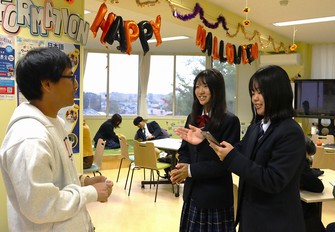
Students gather at Niseko High School’s World Village after school to converse in English with an Assistant Language Teacher (ALT), left, in Niseko, Hokkaido, on Oct. 16, 2025. (Mainichi/Karen Goto)
NISEKO, Hokkaido — Facing closure with only nine new enrollees, the town-run Niseko High School here has remarkably turned its fortunes around in just five years, becoming a sought-after institution with an application rate of 1.5 times the available spots.
The agricultural-focused high school with approximately 100 students will transform into a full-time comprehensive school emphasizing international and entrepreneurial education from the 2026 academic year.
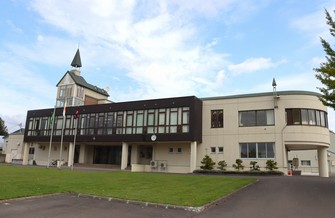
Niseko High School building is seen in Niseko, Hokkaido, on Oct. 16, 2025. (Mainichi/Karen Goto)
How did the miracle happen?
In mid-October, when a Mainichi Shimbun reporter visited the school after all classes had ended, students were enjoying chatting and playing games in English in a classroom decorated with Halloween ornaments.
This scene is part of “Niseko World Village,” the setup that forms the backbone of the international education program offered at the new Niseko High School of International Studies, opening in spring 2026. Also called the “English Village,” the educational facility offers students opportunities to experience English and other languages, and its placement within a high school is apparently rare in Japan.
The Niseko World Village began as a pilot project three years ago and was officially launched in April 2025 after classroom renovations. The concept is a “space for international exchange open to the community.” On this day, six students interacted with four English-speaking adults, including an Assistant Language Teacher (ALT), providing an intimate setting for language practice — something large schools cannot likely offer.
“I’ve become able to communicate in English by coming here every day. It’s fun to finally understand what the ALTs are saying,” says Moe Kitagawa, a 16-year-old second-year student, reflecting on her progress.
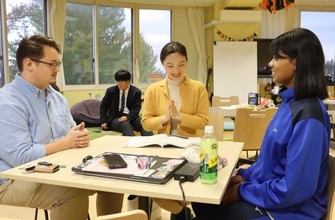
A Niseko Junior High School student, right, receives English speech instructions from people including an ALT at Niseko High School’s World Village in Niseko, Hokkaido, on Oct. 16, 2025. (Mainichi/Karen Goto)
Addressing youth migration and school consolidation
Niseko High opened in 1948 as a branch of Kutchan Agricultural High School, catering to students working on farms. However, as local children showed less interest in farming and more in university education, many left for urban areas. Enrollment dwindled to around 20 students per academic year, half the capacity, and dropped to nine in 2020, putting the school at risk of consolidation.
To reverse this trend, the town government decided to establish a full-time comprehensive school that could attract more students and support the pursuit of higher education through increasing teacher numbers. Principal Hajime Motoya, who took office in 2023, partnered with the town to develop a new vision for the school, focusing on international education by leveraging the area’s characteristics.
Niseko is one of the world’s top winter resorts renowned for its powder snow, and over 10% of its population of approximately 5,000 are foreigners. Through the World Village program, Niseko High has seen new faces during after-school hours and on events, such as students from nearby Niseko Junior High School and international residents.
Eri Kato, a staff member in charge of the World Village, emphasizes, “We aim to be a comfortable gathering place where diverse people from both inside and outside the school can interact. Students come here for various reasons — homework, games, casual chats or career counseling — and in doing so, they develop not only language skills but also an international perspective.”
Students also have numerous opportunities to study abroad, with partnerships with institutions such as YTL International College of Hotel Management in Malaysia and universities in Taiwan. Many students take part in study tours, mutual internship placements and short-term study abroad programs.

English class at Niseko High School is seen in Niseko, Hokkaido, on Oct. 16, 2025. Students are grouped by proficiency level, and one or more ALTs provide support. (Mainichi/Karen Goto)
Implementing reforms while keeping school open
The robust international program has attracted students from within and outside the town. Pirika Kunii, a 17-year-old second-year student from the Hokkaido town of Toyako, said, “I studied in Taiwan during junior high school, and I chose Niseko High as my next step because of its rich network of overseas partner universities.” In 2024, she participated in a six-day study tour in Taiwan, surveying the “linguistic landscape” of street signs and other signage.
“I compared it to Niseko, where efforts for multilingual signage and landscape preservation are advancing, and presented my findings. I want to experience more foreign languages and cultures, and study abroad after graduation,” Prikia said with a smile.
The school also offers entrepreneurship education, with initiatives such as “after-school startups,” allowing students to develop business ideas with local firms’ support, and “Niseko studies,” a unique curriculum exploring topics through the lenses of sustainable development goals, science, tourism and management.
To attract diverse students, Niseko High has become one of the designated institutions accepting students through the “Chiiki Mirai Ryugaku” program, which enables high school enrollment beyond prefectural boundaries.
The school’s reforms have drawn attention, with 58 applicants this year and an admission rate of 1.5 times, making it one of the most competitive public schools in Hokkaido. The new school plans to expand capacity to 70 despite declining birth rates in the country.
Principal Motoya explained the purpose of the swift reforms, saying, “Simply promoting the new school’s appeal by saying ‘This is the kind of school we are’ after it opens won’t win back students. Unless the school undergoes a fundamental transformation while still operating, it will be meaningless.”
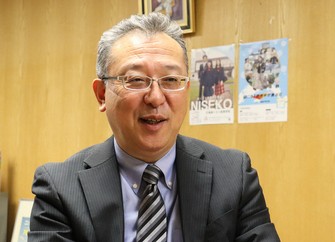
Niseko High School Principal Kazuhiro Motoya is seen in Niseko, Hokkaido, on Oct. 16, 2025. (Mainichi/Karen Goto)
Community support with new dormitory
Motoya aims to cultivate students’ “civic pride” — a sense of pride and attachment to local communities. He said, “I hope that the three years spent here will be a time for them to develop affection not only for Niseko but for the communities where their roots lie. People who feel affection will eventually give back to those communities. That becomes the force that prevents communities from declining.”
The town shares this commitment to education as a means of community preservation. Tatsuzo Kataoka, who became the municipal education board’s superintendent in 2020, stresses the importance of maintaining the town’s only high school, stating, “We wouldn’t realize how important the high school is until it’s gone — and by then it would be too late.”
To accommodate the growing student population, the town government decided in 2024 to build a new dormitory for the high school. The construction cost is 1.2 billion yen (about $7.6 million), and even with subsidies, the town’s burden is significant. However, Kataoka explained the background for the support, saying, “The education board, the mayor and the municipal assembly are all aligned in wanting to keep the school in operation. Many areas have seen local schools close due to poor cooperation with municipalities, but Niseko High School is town-run, making collaboration easier.”
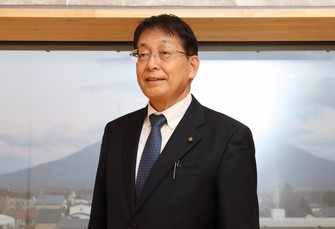
Tatsuzo Kataoka, superintendent of the Niseko Municipal Board of Education, is seen in Niseko, Hokkaido, on Nov. 4, 2025. (Mainichi/Karen Goto)
Having worked as a high school science teacher on remote islands and in small schools within Hokkaido, he has firsthand experience of the challenges and importance of school reform.
“For example, when the eldest son of a two-child family leaves a local town for high school and the younger son follows suit, the parents often move away too. If there’s no high school in a town, families with children will leave there,” he explained.
Based on the belief that “community building is people building, and people building is community building,” Kataoka and the town believe that “the endeavors of Niseko High School of International Studies will support Niseko’s future.”
(Japanese original by Karen Goto, Hokkaido News Department)

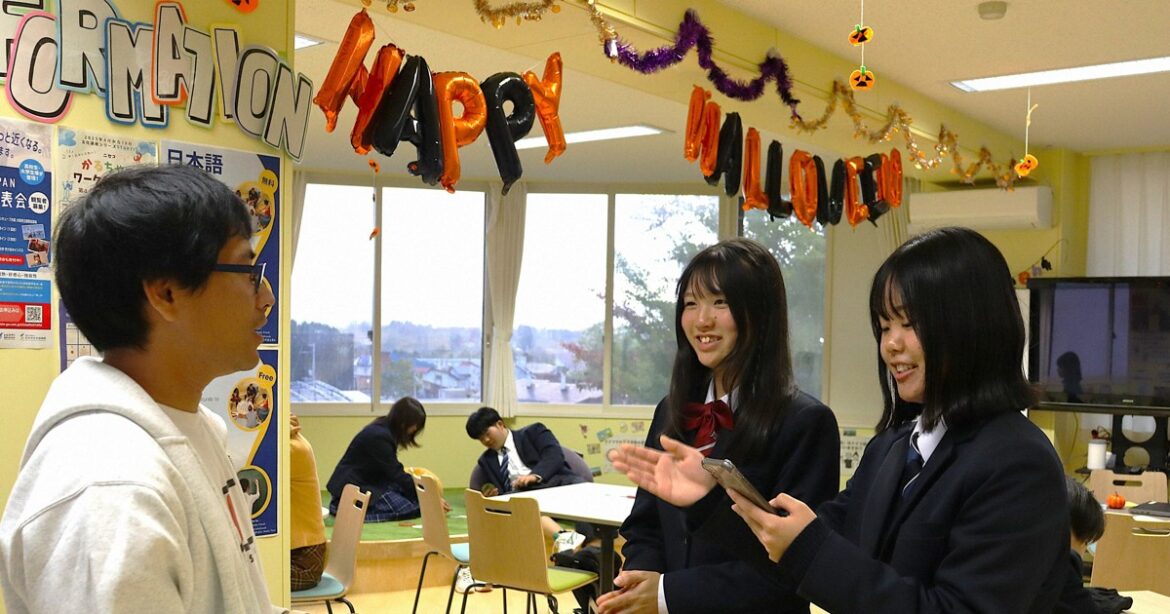
AloJapan.com